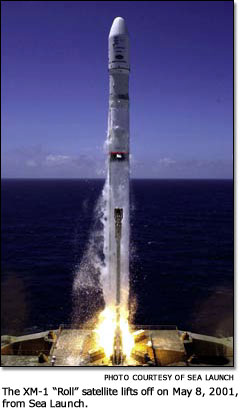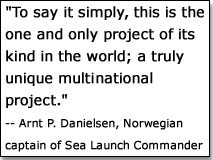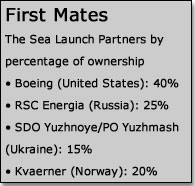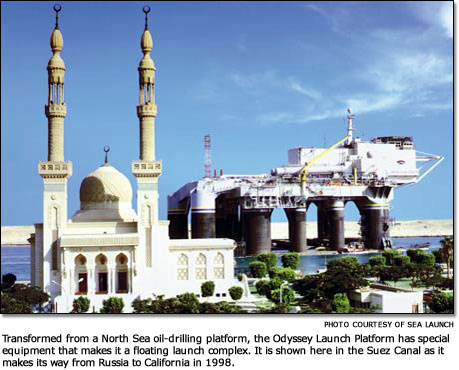| One world, one platform
For Sea Launch's multinational crew,
a cruise on the Pacific Ocean means getting ready for a rocket's liftoff
BY PAULA KORN AND JULIE FORNARO

 Life
can be calm on the 11-day voyage from Sea Launch Home Port in Long Beach,
Calif., to the equatorial launch site about 3,000 miles away. There may
be an international ping-pong match or a basketball game, though these
contests are all in fun and not for Olympic medals. Other times voyagers
enjoy solitude on deck, gazing at a gorgeous sunrise or a peaceful sunset.
And as for the night sky: billions of stars sparkle with breathtaking
brilliance. Life
can be calm on the 11-day voyage from Sea Launch Home Port in Long Beach,
Calif., to the equatorial launch site about 3,000 miles away. There may
be an international ping-pong match or a basketball game, though these
contests are all in fun and not for Olympic medals. Other times voyagers
enjoy solitude on deck, gazing at a gorgeous sunrise or a peaceful sunset.
And as for the night sky: billions of stars sparkle with breathtaking
brilliance.
This tranquil exterior belies a buzz of activity just below the surface
from nearly every corner of these unique vessels — the Sea Launch
Commander and Odyssey Launch Platform. The people of Sea
Launch are engaged in a serious business, and preparation for launch is
a 24/7 operation.
After two years of discussion and study, Sea Launch was formed in April
1995. At that time, Boeing became a 40 percent partner in Sea Launch,
together with companies from Russia, Ukraine and Norway. The partnership,
now called Sea Launch Company LLC, is the only enterprise on the planet
that offers commercial launch services from a floating platform on the
equator.
"To say it simply, this is the one and only project of its kind in the
world; a truly unique multinational project," said Arnt P. Danielsen,
the Norwegian captain of Sea Launch Commander — the assembly
and command ship.
A true testament to the successful melding of multiple cultures, languages
and disciplines, the Sea Launch partners all deliver essential components
to the system. Using its systems integration expertise, Boeing unites
the partners and their technologies, and manages Home Port, where the
vessels are moored and where payload processing activities occur. Boeing
also manages launch operations at sea. As Sea Launch Mission Director
Steve Thelin points out, "This is what Boeing does best: large-scale system
integration."
 "We
work in a multinational, multicultural environment, leading the integration
and operation of a high-technology business that spans both aerospace
and marine technologies in a highly competitive market," said Don Carter,
vice president of operations and general manager of Home Port. "We
work in a multinational, multicultural environment, leading the integration
and operation of a high-technology business that spans both aerospace
and marine technologies in a highly competitive market," said Don Carter,
vice president of operations and general manager of Home Port.
"The Norwegian partner built and now manages the floating launch platform
as well as the assembly and command ship. The Ukrainians make the first
and second stages of the Sea Launch rocket. The Russians add the upper
stage — the Block DM — to the launch vehicle," continued Carter.
What's life like in such an international organization? "It is simply
like working in the average Russian, Ukrainian, Norwegian and U.S. two-ship,
ocean-based satellite-launch service provider with ships crewed by Norwegian,
Dutch, UK, Polish, Swedish and Filipino crew members," said Sea Launch
Director of Security Tod Milton, "nothing special at all."
 What
this global team has accomplished is more than the launching of satellites;
it's helped to launch entire businesses — such as XM Satellite Radio
and Thuraya Satellite Telecommunications Co. What
this global team has accomplished is more than the launching of satellites;
it's helped to launch entire businesses — such as XM Satellite Radio
and Thuraya Satellite Telecommunications Co.
"I have had the opportunity to be involved with Sea Launch since 1996,"
said Kelly Coen, director of payload operations. "In those development
days we would ask ourselves, can we actually launch a Ukrainian rocket
from a Norwegian oil platform from the middle of the Pacific Ocean?" Despite
some uncertainties, the process has proved to be easier than anticipated.
In fact, after assuming that the partners and their respective cultures
would be extremely different from one another, many are amazed at the
similarities.
"What surprised me most about working with so many cultures is how much
we all have in common and how easily we communicate with one another,"
said Jim Maser, president of Sea Launch. "Physics and mathematics are
the same in all cultures, it's just that we each use a different route
to get to the same solution."
In addition to its string of successful launches, Sea Launch is undertaking
initiatives to maintain its competitive position. The Sea Launch team
currently is increasing its rocket performance capability from 5,250 kg
to 6,000 kg (11,550 lb to 13,200 lb). Boeing Launch Services, based in
Huntington Beach, Calif., markets the Sea Launch vehicle as well as the
Delta family of rockets, offering either launch system as a backup option
for the other to provide schedule assurance to commercial customers.
 At
press time, Sea Launch was in full preparations to add the launch of the
Galaxy IIIC satellite to its growing list of missions. Built by Boeing
Satellite Systems for PanAmSat, this 702 model spacecraft will provide
Internet, video, audio and data services to areas of the United States
and Latin America. Three additional launches are planned before year's
end. In 2003, Sea Launch will schedule as many as six missions. At
press time, Sea Launch was in full preparations to add the launch of the
Galaxy IIIC satellite to its growing list of missions. Built by Boeing
Satellite Systems for PanAmSat, this 702 model spacecraft will provide
Internet, video, audio and data services to areas of the United States
and Latin America. Three additional launches are planned before year's
end. In 2003, Sea Launch will schedule as many as six missions.
The company continues to hold its own in a flat commercial launch market
that reflects a decrease in satellite manufacturing orders. Sea Launch
signed seven firm launch contracts in 2001, representing 30 percent of
the year's market share. There are now 17 launches on its manifest.
"Sea Launch's success is the result of a world-class, global team providing
responsive solutions to our customers and meeting our commitments," said
Maser. "Our international workforce makes our work environment truly diverse
and has contributed to our success."
|